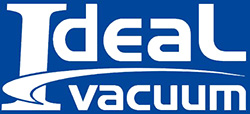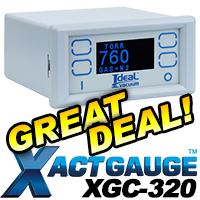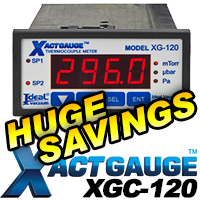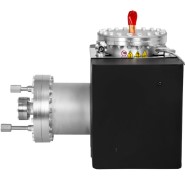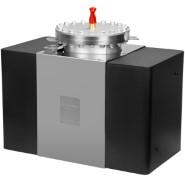Agilent Varian VacIon Plus 300 StarCell Combination Pump with Side Mounted Cryopanel and Titanium Sublimation Pump (TSP)
Agilent Varian Part Number 9192640.
These Agilent Varian VacIon Plus 300 StarCell Combination pumps have a side mounted Cryopanel with Titanium Sublimation Pump (TSP) cartridge and 120 V heater, operate on negative voltage potential, have an 8 inch Conflat intake flange and have a 720 l/s pumping speed of nitrogen. The titanium sublimation creates extra high getterable gases, e.g. CO, CO2, H2, N2, O2, pumping speed while the ion pumping mechanisms handles the non-getterable gases such as argon and methane. A complete technical data and application brochure for the Agilent Varian VacIon Plus 300 StarCell Combination pumps in PDF format is available for download below. These pumps have Agilent Varian part number 9192640.
|
Vacuum pumps in general operate on the basis of maintaining a lower gas density within themselves than exists in the environment they are pumping. This results in a net gas migration into the pump due to the random motion
of the molecules under molecular flow conditions. Once in the pumps, few escape and they are either displaced or captured, depending on the type of pump. Rather than being a displacement pump that actually moves molecules
of gas through it to the atmosphere, the ion pump instead captures and stores them. As a result, at some point in time the pump must be reconditioned or replaced. This is generally required only after many years of use.
|
|
|
|
The generic name Sputter Ion Pump (or Ion Getter Pump) comes from the fact that some of the gas molecules undergo ionization and cause sputtering of the sputtering agent. This material chemically reacts with the active gases to
form stable compounds that are deposited on the internal walls of the pump. The getter, usually titanium, is provided by a plate or electrode of that material, which is in turn sputtered and eroded by gas ions formed under the
influence of the high voltage. These electrical potentials are usually in the range of 3,000 to 7,000 VDC. An external permanent magnetic circuit generates a magnetic field, usually ranging from 800 to 2,000 G, parallel to the anode cell axis.
The function of the anode cell structure is to contain a “cloud” of high energy electrons which are constrained by the magnetic field. Most ionization devices operate in the same way. Gas molecules are bombarded by high energy electrons when a collision occurs.
A molecule may lose one or more of its own electrons and thereby is left as a positively charged ion. Under the influence of a strong electric field, the ion is accelerated into the titanium cathode. The force of this collision is
sufficient to cause atoms to be ejected from the cathode and “sputtered” onto the adjacent walls of the pump. Freshly sputtered titanium is extremely reactive and will chemically react with active gases. The resulting compounds accumulate
on surfaces of the pump elements and pump walls. Active gases are those such as oxygen, nitrogen, CO, CO2, and water, as opposed to the noble gases like helium, neon, argon, krypton, and xenon, which are nonreactive. The latter are pumped by
“ion burial” (ion burial is the “plastering over” of inert gas atoms by the sputtered getter atoms).
The ability to read pressures using an ion pump is due to the direct proportionality between pump current and operating pressure. The reliability of pressure readings at very low pressure is limited by leakage current, and the leakage
current from field emission is heavily dependent on the voltage applied to the pump. The Dual controller, designed for use with any VacIon Plus pump, provides the unique ability to adjust the voltage in accordance with the operating pressure.
By doing this, the leakage current is minimized at low pressure, providing a reliable pressure reading down to the 10-10 mbar range.
The VacIon Plus Family
Ion pumps are commonly used to create Ultra High Vacuum (UHV), due to their cleanliness, ability to pump different gases, along with maintenance-free and vibration-free operation. Long operating life and ability to read pressure
are other important features of ion pumps. The VacIon Plus family has been designed to enhance all of these characteristics and thus offers the most advanced and valuable solution to any ion pumping requirement.
In general, all ion pumps can pump all gases to some degree. To obtain the best performance and base pressure, different types of ion pumps have been developed with optimized performance in different pressure ranges and with different gases.
Agilent Varian's VacIon Plus is a complete product family that offers the choice among three different elements:
Diode, Noble Diode and StarCell. Whatever the application, there is a VacIon Plus pump designed for it.
Diode VacIon Plus
The diode version of the VacIon Plus pump has the highest pumping speed among all ion pumps for oxygen (O2), nitrogen (N2), carbon dioxide (CO2), carbon monoxide (CO), and any other gatherable gas.
It provides the highest pumping speed and capacity for hydrogen (H2) as well. Its simple mechanical structure allows a reliable current/pressure reading down to very low pressures, as well as absolutely vibration-free operation.
Its geometric and electrical configuration allows it to be used in the vicinity of electron detectors or similar devices. Diode VacIon Plus pumps are therefore widely and successfully used in general purpose UHV systems, for evacuating
electron devices and in the most sensitive electron microscopes. However, diodes are not suggested for applications where noble gases such as argon (Ar), helium (He), and methane (CH4) are to be pumped.
Noble Diode VacIon Plus
The Noble Diode VacIon Plus element is a version of the diode element, in which a tantalum cathode is substituted in place of a titanium cathode. This substitution allows a higher pumping speed and stability for pumping
noble gases (mainly argon and helium). The element is otherwise equivalent to the Diode VacIon Plus. Noble Diode VacIon Plus pumps are used in any application where pumping of noble gases is an important characteristic.
As with the diode configuration, the Noble Diode retains a consistent pumping speed for all gases at very low pressures. However, pumping speed for H2 and gatherable gases is lower than for the corresponding
Diode pumps. The Noble Diode VacIon Plus is typically used in UHV applications where a mixture of gas is to be pumped and where the pressure is quite constant (i.e., no sudden gas burst or systematic high pressure cycling).
Its characteristics of consistent speed for almost any gas even at very low pressures make it ideal whenever the ion pump alone is used to obtain UHV pressures. This is often the situation in particle accelerators or synchrotron
rings, as well as in surface analysis applications. Other VacIon Plus versions are suggested whenever the application requires cycling to higher pressures, pumping of large amounts of H2, or when the ion pump
is combined with other UHV pumps such as Titanium Sublimation Pumps or Non-Evaporable Getters.
StarCell VacIon Plus
The StarCell VacIon Plus element is the latest variation of the Triode configuration. Its patented design makes this ion pump the only one that can handle a high amount of noble gases (better than Noble Diode) and hydrogen
(comparable to the Diode). Furthermore, this pump provides the highest speed and capacity for methane, argon, and helium. Its high total capacity for all the different gases, together with its very good speed performance at
relatively higher pressures, makes the StarCell VacIon Plus ideal for applications requiring constant operation at
10-8 mbar or above. This typically includes Electron Microscopes and Mass Spectrometers.
Its high pumping speed for argon, helium, and methane (the highest of any ion pump at any pressure) has made StarCell the standard for any application where the ion pump is used in combination with Titanium Sublimation Pumps (TSP)
or Non-Evaporable Getters (NEG) pumps, where its pumping performance is enhanced. The lowest attainable pressure has been obtained with combinations of StarCell VacIon Plus and TSP/NEG pumps, thanks to the optimized characteristics
of these combinations. Most existing particle accelerators and synchrotron sources, beam lines, transfer lines, and similar devices have used and are successfully using these combinations to obtain the maximum speed for all the gas species.
|
Pumping Speed
The most common parameter used to express the capability of a pump to remove molecules from a given volume is pumping speed. It is usually measured in liters per second and expresses the volume of gas (at a given pressure)
removed per time unit. In an ion pump the net pumping effect results from the sum of different phenomena:
|
|
|
|
• The pumping action of the getter film produced by the sputtering of cathode material by ion bombardment.
• The pumping action due to the ion implantation and diffusion into the cathode.
• Gas burial on the anodes and pump walls.
• The gas re-emission from the cathode due to cathode heating and erosion.
Lifetime
When an ion pump is new or has been regenerated, for example by baking, the surface layer of the cathode is clean and the gas re-emission from it is negligible. In this condition, the ion pump is called “unsaturated” and the pumping effect is due
both to the gattering effect as well as to ion implantation and diffusion. As the number of gas molecules implanted into the cathode increases, the re-emission of them due to the ion bombardment increases. As a consequence, the net pumping speed
decreases until an equilibrium condition between ion implantation and gas re-emission is reached. In this condition, the ion pump is “saturated” and the net pumping speed, due only to the gettering action of the material sputtered from the cathode,
is about half the pumping speed of the unsaturated pump. Since the saturation effect depends on the quantity of gas molecules implanted into the cathode, the time required to saturate an ion pump is inversely proportional to the pressure at which
the pump is operated. Thus, the lower the pressure, the longer the time before the pump saturation occurs.
In an ion pumped UHV system with a proper bake-out procedure (and consequent pump regeneration), a pressure in the 10-11 mbar range is possible. At this pressure, the ion pump will work at the higher (unsaturated) pumping speed values for
a few years before it is saturated.
Active Gases (N2, 02, CO, CO2...)
A characteristic of these gases is their ability to easily react with most metals forming stable compounds. In an ion pump, these active gas molecules react with the fresh titanium film produced by the sputtering of the cathode material. These active
gas molecules do not diffuse deeply in the cathode. The saturation effect, due to the re-emission of these molecules trapped on the cathode surface, is very strong. Diode and Noble Diode elements show a higher pumping speed at low pressure while StarCell
elements perform better at higher pressure.
Hydrogen
Hydrogen is an active gas but, due to its very small mass, the sputtering rate is very low. In spite of this fact, the pumping speed for H2 is very high because it quickly diffuses into the cathode with negligible re-emission. When pumping H2,
the ion pump always works in the unsaturated condition. As a result, the nominal speed for H2 is about twice the corresponding value for nitrogen. Furthermore, if some traces of heavier gases are present, the increased sputtering rate produces an even higher hydrogen pumping speed.
The Diode element shows a higher pumping speed than the Noble Diode since the H2 solubility in the tantalum cathode is lower than in a titanium cathode. StarCell elements combine good performance at higher pressures with enhanced capacity for H2.
Noble Gases (He, Ne, Ar, Kr, and Xe)
Noble gases are pumped by being buried by titanium. Noble gas ions can be neutralized and scattered from the cathode without losing their energy. These neutral atoms maintain enough energy to implant or stick on the anode and on the pump walls where they will be
buried by sputtered titanium and thus permanently pumped. In the Diode configuration, the neutralization and back scattering probability is very small, thus the pumping speed for noble gases is only a small percentage of the N2 pumping speed. Moreover,
when operating at a relatively high argon partial pressure (i.e., higher than 10-8 mbar), sudden bursts of pressure due to the re-emission of temporarily implanted argon in the cathode is observed. After this occurs, a Diode pump is not able to pump more
argon until its source is stopped. This phenomenon is known as “argon instability”.
In the Noble Diode element, one titanium cathode is replaced with one tantalum cathode. The high nuclear mass of tantalum increases the back-scattering probability and consequently the pumping speed for noble gases. The best results in terms of pumping speed of
noble gases are obtained using the open cathode structure typical of StarCell elements. In these configurations, the flat cathode structure has been replaced with a structure that allows glancing collisions with ions. These are neutralized and then forward scattered
toward the pump wall or the anode with a much higher probability than in the flat cathode case. The result is a pumping speed for noble gases of up to 60% of N2. Furthermore, due to the unique design that allows optimal use of all the available titanium,
the operating life of a StarCell pump is about 50% longer than all the other pumps.
Methane
Although methane is not a noble gas, it does not react with any getter material. It is always present to some degree in UHV systems as a reaction product of hydrogen and carbon present in the vacuum system walls. Methane is a particular problem in electron accelerators
where it is the main cause of the beam decay. Due to the Penning discharge in ion pumps, the methane molecule (as well as other hydrocarbon molecules) is cracked and transformed into smaller "gettered" compounds (C, CH3, ... H). The result is that the pumping
speed for methane and light hydrocarbons is always higher than the speed for N2.
- Agilent Varian Quality Manufacturing
|
|
Cleanliness
To reach very low pressures (i.e. 10-11 mbar) in any system, both the chamber and pump outgassing must be minimized. If not cleaned properly, the ion pump itself can be a source of gas at UHV. In order to ensure cleanliness
VacIon Plus Pumps are factory processed at high temperature in ultraclean vacuum for a thorough outgassing of the body and all internal components. The cleanliness of the ion pump element is even more critical, due to the continuous cathode bombardment.
Any gas trapped on the surface or in the bulk of the cathode will eventually be released.
|
|
|
|
Ion Pump Outgassing
The ion pump outgassing system is a thermal process of the pump body, completely computer controlled and able to provide an automatic final test of the achieved pump specifications. The bake-out of the pump is done in a nitrogen-controlled atmosphere
to protect the external pump body from oxidation.
The system is based on the principle of thermal outgassing the ion pump internal surfaces through the control of their intrinsic outgassing. Therefore pressure, not time, is the driving factor of the overall process.
The bake-out time depends on the internal cleaning of the pump components and all the pumps will have, in this way, the same final outgassing rate and base pressure.
At the end of the thermal process, once room temperature is achieved, an RGA is performed. The gas analyzer, placed on the vacuum system, provides the spectrum of the different gases degassed by the pump. If H2 and the other peaks normally present
in a well-baked vacuum system exceed the acceptance levels, the pump is baked again. Otherwise, it is pinched off and its base pressure monitored. The base pressure is evaluated through the ion current reading. The current decrease is computer monitored, and the pump is ready to be shipped only after the base current is reached.
Long Operating Life
All VacIon Plus pumps have rated lives in excess of many thousands of hours at a pressure of 1x10-6 mbar (50,000 hours for the Diode pump, and 80,000 hours for the StarCell). With many ion pumps, maintenance may be required well before the rated life, due to metallization of insulators or pumping element distortion.
All VacIon Plus elements are designed to minimize cathode distortion (even after repetitive bake-outs and starting at high pressure), and the insulators are protected from sputtered titanium by using a double re-entrant design and a cap shield.
